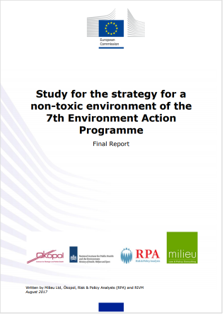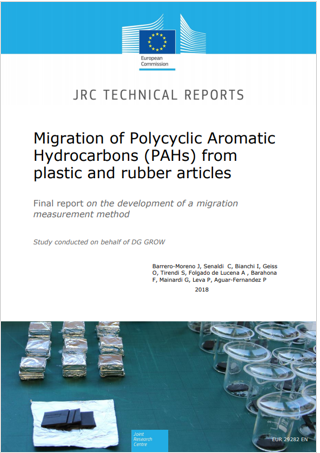Informazione tecnica HSE / 25 ° anno
/ Documenti disponibili:
45.449
/ Documenti scaricati: 34.179.915
/ Documenti scaricati: 34.179.915

Final Report August 2017
The 7th Environment Action Programme (7th EAP), adopted in 2013 by the European Parliament and the Council, mandates the European Commission, inter alia, to develop by 2018 “a Union strategy for a non-toxic environment that is conducive to innovation and the development of sustainable substitutes including non-chemical solutions”.
The EU’s current legislative framework is anchored by the 2006 REACH Regulation and CLP, a major milestone in the effort to establish a regulatory framework able to keep abreast of the challenges of ensuring a high level of protection of human health and the environment, whilst promoting the free circulation of substances on the internal market and enhancing innovation and competitiveness.
Under the European Commission’s better regulation programme (REFIT), all EU chemicals legislation except REACH is undergoing a comprehensive fitness check, expected to be finalised in 2017, and a REFIT evaluation of REACH is nearly completed. The preliminary results of this stocktaking of EU chemicals legislation to date indicate that the current instruments are basically still fit for purpose. However, some gaps have been identified, e.g., a lack of controls over substances in articles, including imported articles. Separate Commission processes are also considering other problem areas, namely combination effects, nanomaterials and endocrine disruptors.
The gaps and problem areas mentioned above are strongly interconnected and closely linked with the current chemicals acquis. In particular, some type of process or mechanism that acts horizontally across the various pieces of EU legislation that deal with chemical risks and pollution appears to be needed, in order to ensure a coherent approach to achieving the EU’s longer-term objectives and goals as well as to meet its international commitments with regard to the protection of human health and the environment.
This study complements all of the Commission processes mentioned above. It provides support for the development of the non-toxic environment strategy by examining the possible building blocks of the strategy. It focusses on the following topic areas selected by the Commission:
- Substitution, including grouping of chemicals & measures to support substitution (sub-study a);
- Chemicals in products (articles) and non-toxic material cycles (sub-study b);
- The improved protection of children and vulnerable groups from harmful exposure to chemicals (sub-study c);
- Very persistent chemicals (sub-study d);
- Policy means, innovation and competitiveness (sub-study e);
- Programme on the development on new, non/less toxic substances (sub-study f);
- Early warning systems for examining chemical threats to human health and the environment (substudy g).
Sub-studies b, c and d present assessments of the information available concerning the scale of the problem, as well as analyses of gaps, deficits and improvement opportunities in their respective areas. Sub-studies a, e, f and g explore possible ways forward. This final report summarises key findings.
...
TABLE OF CONTENTS
LIST OF FIGURES
ABSTRACT
EXECUTIVE SUMMARY
ABBREVIATIONS USED
1 INTRODUCTION
2 STUDY OBJECTIVES AND METHODOLOGY
2.1 Objectives
2.2 Methodology
3 THE ROLE OF CHEMICALS IN MODERN SOCIETY AND INDUSTRY
4 CHEMICAL REGULATION IN THE EU AND GLOBALLY
4.1 The EU regulatory framework for chemicals
4.2 Overall global policy initiatives
4.3 National initiatives outside of the EU – examples from the USA and Canada
5 THE STATE OF PLAY, INCLUDING NEW AND EMERGING HEALTH AND
ENVIRONMENTAL CONCERNS
5.1 Implementation of the current policy
5.1.1 Evaluation of substances
5.1.2 Progress in substitution
5.1.3 Grouping approaches
5.1.4 Innovation challenges
5.1.5 A programme on new, non-/less toxic substances
5.1.6 Early warning systems
5.1.7 Enforcement
5.2 Chemicals in articles and the Circular Economy
5.2.1 Challenges for non-toxic articles
5.2.2 Challenges for waste management and non-toxic materials
5.2.3 The Current Policy and Legislative Framework
5.2.4 Gaps and deficits in policies and legislation
5.2.5 Conclusions
5.3 Persistence
5.4 The protection of vulnerable groups
5.5 Other existing and emerging health concerns
5.5.1 Combination toxicity
5.5.2 Endocrine-disrupting chemicals
5.5.3 Nanomaterials
5.6 Emerging environmental concerns.
5.6.1 The concept of planetary boundaries
5.6.2 The contribution of chemical pollution to a loss of biodiversity, contamination of natural resources, and resilience of ecosystems
5.6.3 Chemical pollution and climate change.
6 WORKSHOP PARTICIPANTS’ VIEWS ON STATUS QUO AND IMPROVEMENT OPPORTUNITIES
6.1 Substitution, including grouping of chemicals and measures to support substitution (sub-study a)
6.2 Chemicals in products and non-toxic material cycles (sub-study b)
6.3 The improved protection of children and vulnerable groups from harmful exposure to chemicals (sub-study c)
6.4 Sub-strategy for very persistent chemicals (sub-study d)
6.5 Policy means, innovation & competitiveness (sub-study e)
6.6 Programme on new, non-/less toxic substances (sub-study f)
6.7 Early warning system for emerging chemical risks (sub-study g)
6.8 Common points
7 ELEMENTS FOR THE NTE STRATEGY: REDUCING EXPOSURE WHILE MAINTAINING COMPETITIVENESS
The non-toxic environment in the global policy context and in the 7th 7.1 EAP
7.1.1 Global policy context
7.1.2 Chemicals under the 7th 7.1.2 Environment Action Programme
7.1.3 The objective of a non-toxic environment
7.2 Gaps and deficits identified in the seven sub-topics
7.2.1 Introduction
7.2.2 Information on hazard, risk and fate of the substance at different stages of the product life cycle
7.2.3 Information on uses/applications of substances and potential alternatives
7.2.4 Analytical tools
7.2.5 Communication and awareness
7.2.6 Resources, guidance and training
7.2.7 Functioning of the market
7.2.8 Functioning of the legislation
7.2.9 Enforcement
7.3 Identified responses to gaps and deficits (Building blocks for the NTE Strategy)
7.3.1 Introduction
7.3.2 Information on hazard, risk, life cycle
7.3.3 Information on uses and alternatives
7.3.4 Analytical tools
7.3.5 Communication and awareness
7.3.6 Resources, guidance and training
7.3.7 Functioning of the market
7.3.8 Functioning of the legislation
7.3.9 Enforcement
7.3.10 Monitoring
7.4 The range of policy instruments suggested
7.5 Bringing it all together
8 CONCLUSIONS
8.1 Progress already made via the current EU Regulatory Approach
8.2 Summary of gaps identified and need for a strategy for a NTE
8.3 Ways forward
BIBLIOGRAPHY
LIST OF FIGURES
Figure 1: Projected growth in chemicals production in comparison to growth in global population
Figure 2: Percentage of output consumed by customer sector
Figure 3: Projected growth in chemicals production in comparison to growth in global population
Figure 4: Consumption of chemicals by human health hazard
Figure 5: Archetypal cases of incremental substitution for selected phase-out chemicals used in large applications in consumer products
Figure 6: Components and Steps involved in an EWS
Figure 7: Gaps and deficits tree
Figure 8: Overview of elements for a strategy for a non-toxic environment
Figure 9: Hierarchy on uses of chemicals
LIST OF TABLES
Table 1: Frequency of gaps and deficits by broad category in each sub-study
Table 2: Frequency of identified responses by broad category in each sub-study
Table 3: Overview of current policy instruments
Table 4: Frequency of identified responses by policy instrument.
Fonte: Commissione Europea
Correllati:
Regolamento (CE) n. 1907/2006 REACH
Regolamento CLP Testo Consolidato

JRC 2018
Rapporto finale sullo sviluppo di un metodo di misurazione della migrazione - Studio
Gli idrocarburi polici...
Comunicazione della Commissione al Consiglio, al Parlamento Europeo e al Comitato economico e sociale europeo relativa all’attu...

ID 20474 | 27.09.2023
Regolamento (UE) 2023/2055 della Commissione del 25 settembre 2023 recante modifica dell...
Testata editoriale iscritta al n. 22/2024 del registro periodici della cancelleria del Tribunale di Perugia in data 19.11.2024